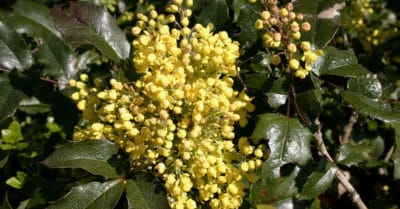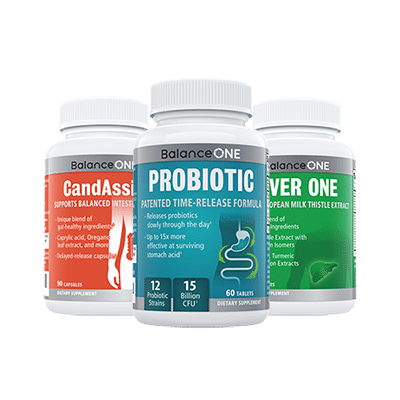Oregon Grape As A Natural Antifungal

One of the lesser-known medicinal herbs, Oregon grape was named as the ‘state flower’ of Oregon by pioneers who harvested it on the Oregon trail. Interestingly, it’s not actually a grape – it’s an evergreen shrub.
The medicinal properties of Oregon grape are in its root. Although it was also used as a food source, it’s the powerful therapeutic actions of Oregon grape that earned it its status as a natural antibiotic. It’s also very similar to another well-known natural healer, Barberry.
Oregon grape root is available in a powder, extract, or a tea. In traditional medicine, it’s been used to treat everything from diarrhea to psoriasis. It’s also an important antifungal agent and can be used alongside other antifungals such as caprylic acid, coconut oil, and oregano oil to fight Candida overgrowth.
Berberine has been shown to kill a wide range of bacteria and viruses. In fact, it’s believed to be as effective as a pharmaceutical drug. Chinese and Ayurvedic practitioners have been using berberine to treat infectious conditions for centuries. In China, it’s used in an OTC medication called Huang Lian Su Wan, which is used to treat gastrointestinal infections. It’s only in the last few decades that scientific research has shown the Western world just how powerful berberine is.
Table Of Contents
How Does Oregon Grape Work?
Oregon Grape’s powers are in its famous active ingredient, Berberine. Berberine is a well-researched alkaloid also found in other natural antibiotics such as goldenseal and barberry.
Traditional herbalists discovered Oregon grape’s berberine content by scratching a tiny patch of the shrub’s bark. The berberine content in Oregon grape is found in the entire plant, from its flowers to its roots. Other plants in Oregon Grape’s family (known as Berberidaceae) only contain smaller amounts of berberine in their stems.
Antifungal
Berberine is well-known for its potency against a wide range of bacteria and fungi. A 2011 paper reported that Berberine has the ability to inhibit the growth of various Candida species, including Candida albicans.
Berberine is also shown to kill Candida yeast strains that have become resistant to pharmaceutical antifungals such as fluconazole. Researchers found that Berberine was not only able to inhibit the growth of the Candida strains, but to destroy the yeast cell so that it could not survive. It was also able to damage the Candida albicans plasma membrane.
Antimicrobial
Unlike many pharmaceutical antibiotics and natural antifungals, Berberine can continue to kill off bacteria that have become resistant to antibiotics. It can even inhibit the growth and spread of multidrug resistant strains of Mycobacterium tuberculosis and methicillin resistant Staphylococcus aureus.
Berberine is effective against methicillin-resistant Staphylococcus aureus (MRSA), a potentially fatal disease sometimes contracted in hospitals due to the bacteria’s multi-drug resistance, and also the Streptococcus bacteria (Streptococcus agalactiae).
Blood Sugar Regulator
Studies have also shown that Berberine can help regulate blood sugar levels, preventing the spikes that can feed a Candida overgrowth. It does this by stimulating the uptake of glucose into cells, improving glucose sensitivity and reducing the production of glucose in the liver.
Gut Healer
Natural health practitioners use Berberine to treat gastrointestinal infections and boost the immune system, thanks to its ability to kill pathogens and heal the lining of the gut. We often see that Candida and Leaky Gut Syndrome go together. Berberine can also improve the gut microbiota when cells have been damaged by bacteria. It’s also thought to activate white blood cells, which makes them better at fighting infection.
Oregon grape’s gut-healing powers make it an excellent choice in treating Candida, as the lining of the gut is often damaged by yeast overgrowth.
Antioxidant
Berberine’s powerful anti-inflammatory properties also go a long way in reducing oxidative stress caused by free radicals in the arteries, as well as bringing down inflammation that contributes to further arterial damage.
Other Benefits Of Oregon Grape
Oregon grape’s Berberine content is also linked to its ability to
- Stimulate the immune system
- Induce relaxation
- Reduce inflammation
- Improve heart function
- Reduce the risk of heart disease
- Help prevent Alzheimer’s Disease
- Treat depression
- Reduce the pain of arthritis
- Lower blood pressure
How Do You Take Oregon Grape?
Oregon Grape is available in supplementary form as a tincture, but can also be taken as a tea. It may also be available in health food stores as a powder or extract.
- Liquid tincture: Be sure to note the manufacturer’s dosage instructions. Typical dosage is half a teaspoon, three times a day.
- Extract: This is taken using a dropper. Dosage is usually once or twice daily with meals.
- Tea: Boil 2 teaspoons of Oregon Grape root in 2 cups of water for fifteen minutes. Most health practitioners recommend a daily intake of around 2-3 cups per day.
- Topical treatment: Oregon grape may also be used on the skin as a salve or powder to treat skin infections or abrasions. Consult with a health professional before applying.
Who Should Not Take Oregon Grape?
Women who are pregnant or breastfeeding are not advised to take Oregon Grape, mainly due to its Berberine content. Berberine is known to cause uterine contractions, which may result in complications with pregnancy.
Individuals with chronic health issues such as kidney disease, live disease, heart disease, or other serious conditions seek advice from a health professional before commencing treatment with Oregon grape.
Although Oregon grape is generally known to be safe, it is recommended to limit consumption to small quantities. Health professionals also advise that supplementation with Oregon grape should not exceed more than three weeks.
When Should You Take Oregon Grape?
Oregon grape is an antifungal that could be taken during the Antifungals stage of your Candida plan. It’s important to ‘stagger’ your approach and avoid putting too much pressure on your immune system and detoxification pathways. This is why you should start taking your antifungals at least a week away from starting your probiotics.
For lots more information on how to choose the right antifungals, and how to integrate them into a comprehensive treatment regimen, take a look at our Ultimate Candida Diet treatment plan.

3-Month Candida Elimination Kit Start Your 3-month Candida Cleanse
This Candida Kit contains all the supplements recommended on the Candida Diet:
- LIVER ONE to process and remove the toxins created by Candida.
- CANDASSIST to inhibit and weaken the Candida colonies in your gut.
- PROBIOTIC to replace the Candida yeast with probiotic bacteria.
Plus... the CANDIDA DIET RECIPE BOOK with 50+ low-sugar recipes

Leave a Reply